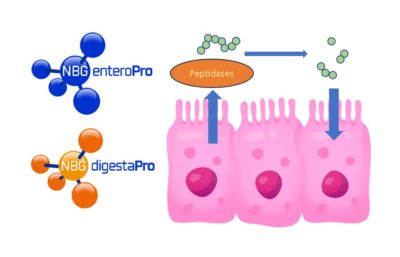Why do protein hydrolysates improve digestibility beyond their own nutritional contribution?

Dear colleagues,
Today we will explain that, once protein is digested, it is absorbed by enterocytes in the form of free amino acids and dipeptides and tripeptides by specific transporters that exist in the microvilli of enterocytes.
Although some peptides with more than three amino acids can also be absorbed when recognized by certain membrane receptors and by transcytosis, this is not a common method of transport, but it is essential in certain cases, for example in piglets to absorb maternal immunoglobulins secreted by colostrum.
Dipeptides and tripeptides are transported more quickly than amino acids, so a good balance between free amino acids and peptides may be the best combination to provide an almost immediate protein source to the enterocyte. Once absorbed, peptides and amino acids are released into the bloodstream and end up mainly in the liver, although certain amino acids, such as branched-chain amino acids, have tropism for muscle and brain, and glutamine and asparagine for the intestine and kidney.
The key to the effect of protein hydrolysates on diet digestibility is that the final part of the digestion process is carried out by peptidases, disaccharidases, and phosphatases produced by the enterocytes themselves, enzymes, and therefore proteins, which must be constructed from amino acids.
Thus, a source of immediately absorbable protein in the form of free amino acids, dipeptides, and tripeptides can very effectively aid in the digestibility of the diet, acting as a digestive tonic that helps enzyme production in enterocytes at the beginning of the digestion process in the small intestine.
Finally, we would just like to remind you that not all hydrolysates are equally effective, as the origin of the raw material and the type of hydrolysis can greatly affect important parameters such as palatability and the presence or absence of bioactive peptides. At NBG, we produce fish protein hydrolysates using NBG EnzyGoal technology, based on specific enzymatic hydrolysis to obtain maximum potential when incorporated into animal diets:
Finally, we have attached an article that shows how a hydrolyzed protein has an accelerated absorption rate compared to its non-hydrolyzed variant.
Enjoy the article!

